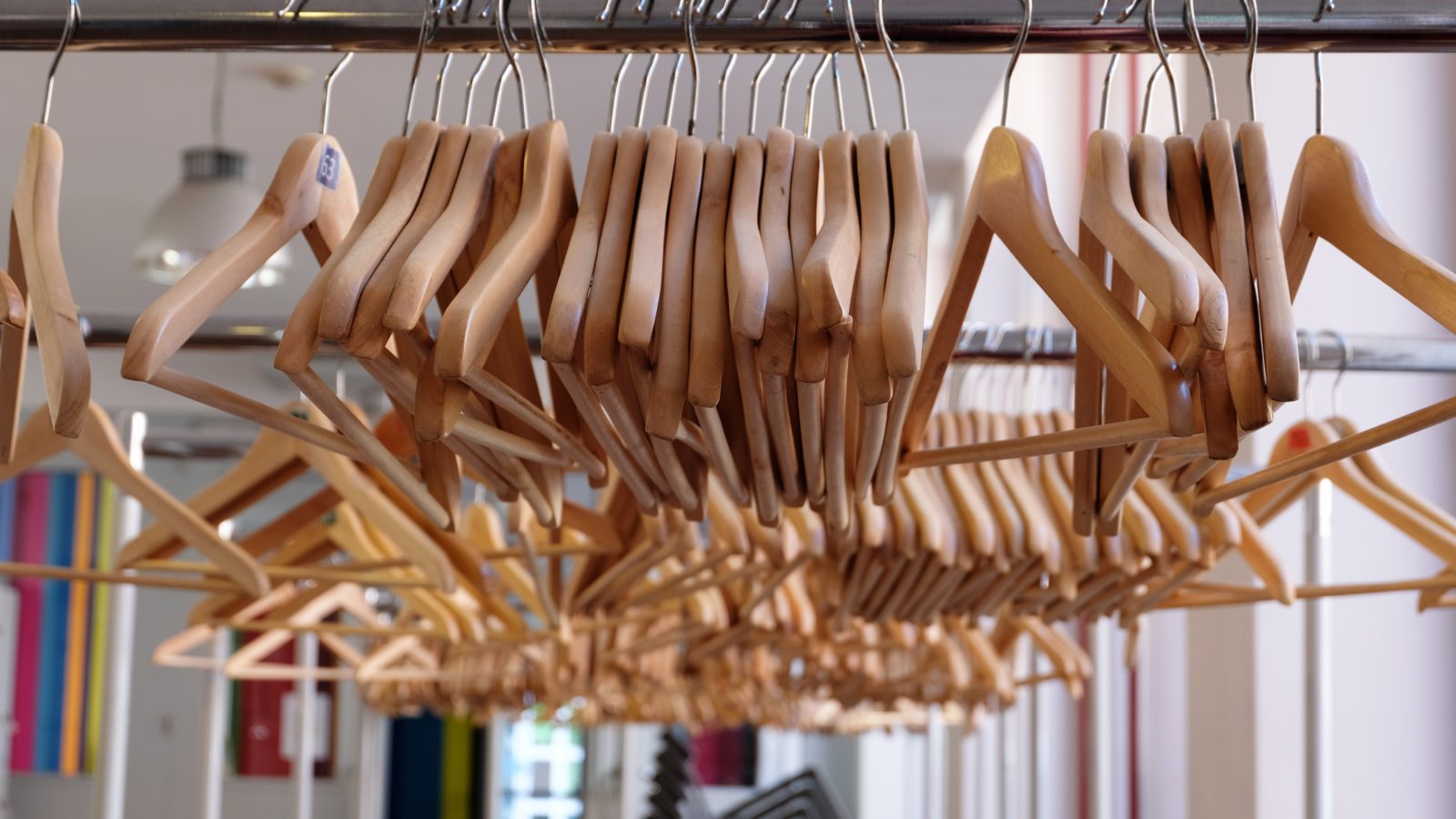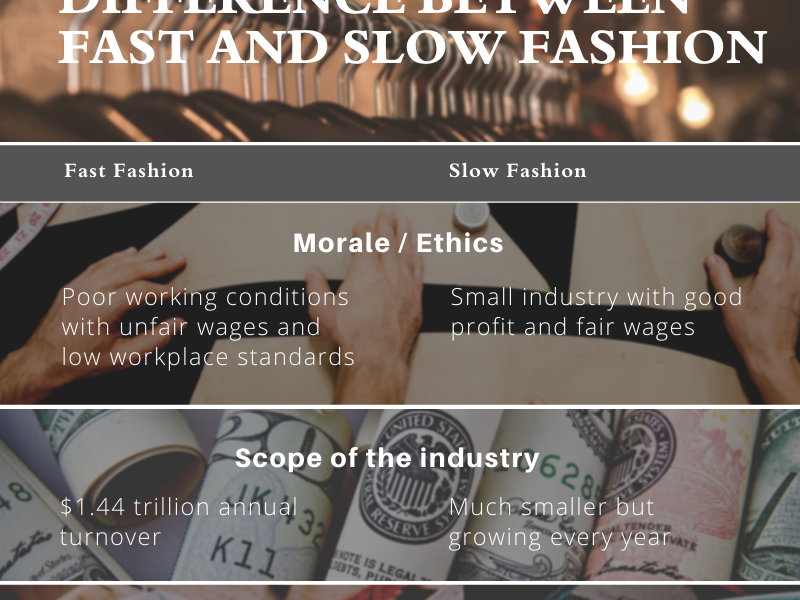I think most people have heard of the term fast fashion now. The term flies around a lot when levelling criticism at big fashion brands. In response to the damaging effects of fast fashion a new movement has formed, slow fashion. Slow fashion is gaining a lot of attention and is creating new ways to design, manufacture, and purchase clothing.
According to Google Trends, 2019 saw a huge peak in search interest for the term “slow fashion”.
But with a $1.44 trillion juggernaut of an industry, changing the consumer tide is going to be a slow process.
But isn’t it all just marketing jargon and greenwashing?
What exactly are fast and slow fashion, and what are the differences between them?
Let’s explore.
What is fast fashion?
Fast fashion refers to cheap, mass-produced clothing often replicating the newest styles unveiled on catwalks and fashion shows.
Fashion trends move quickly and with fashion brands chasing increasing profits, a downward spiral has developed in the industry.
Manufacturers mass-produce garments at lightning speed to beat competition and keep up with customer expectations.
This constant demand in the fashion world to outperform causes numerous knock-on effects. As consumers now demand and expect more for less, creating a race to the bottom in price and quality.
Clothing is produced quickly and cheaply, hence the term fast fashion.
Fast fashion appears beneficial commercially but the industry as a whole is under massive pressure to keep up the pace while slashing prices.
The chase for new style at rock bottom prices leads to corners being cut in quality, workplace practices and environmental sustainability. In fact, some areas of fashion are in such a rush that quite often garments go out of fashion before they hit the high street.
Fast Fashion Problems
Fast fashion is damaging in almost everything it touches with the environment, product quality and supply chain workers hit hardest.
Environmental damages of fast fashion
Like many areas of modern consumerism, the environment is left to take the brunt of human greed.
The fast processes used in the fashion industry require cheap unnatural materials produced via poor agriculture practices, toxic chemicals and synthetic fabrics.
In fact, the fashion industry is the second largest polluter of the worlds clean water sources.
When I hear that, I’m wondering what on Earth fashion does to water… The thing that is essential to the functioning of all known life forms.
Unfortunately, factories use toxic chemicals to dye and waterproof clothing. Quite often these chemicals escape into the environment during the manufacturing process. Even more worryingly, anything that makes its way into the water supply ends up in the food chain.
Creating low-cost garments also requires man-made fabrics like polyester and other acrylics. This is devastating to our planet too as these crude oil by-products shed microfibre plastics plus become almost impossible to dispose of.
Even clothing made from more natural products leads to environmental destruction when exposed to fast fashion. For example, demand for cotton is ruining habitat and agriculture. Cotton farmers sink to the bottom of the supply chains, left with poor pay and no option but to employ destructive agriculture methods to survive.
Social damage of fast fashion
So fast fashion crushes the environment but what about the people involved in creating these clothes?
It is no secret that the race to the bottom leads to terrible treatment of workers in the supply chain from farmers to factory workers.
If the final product is cheap then you can guarantee that the people making it are not being treated fairly. Low wages, hazardous working conditions and lack of human rights continue to be the cost of producing cut rate fashion.
Along with price, speed is also crucial to mass production, meaning workers become overworked and even results in child and slave labour being used to meet demands.
It’s the communities in deprived countries paying the price for high street fashion.
Ethics in the fashion industry has been taking on human rights issues for years. It’s where the slow fashion movement kicked off before incorporating environmental and sustainability concerns in recent years.
Reducing quality of fast fashion garments
Sustainability takes a hit from fast fashion putting yet more pressure on this cycle of doom.
The rush for cheap clothes results in poor quality clothing. Cheap materials, corners cut on build quality, and inadequate designs all contribute to fashion garments that simply don’t last.
With durability compromised clothing doesn’t last long and this has a number of effects. Firstly, what happens to the damaged items? Most of it ends up in landfill, literally wasting these materials and since 90% of it is man-made fabrics it doesn’t decompose.
Secondly, consumers head out to buy more cheap clothing adding to demand. You can’t expect a pair of £10 shoes to last long, be waterproof or even be good for your health.
What is Slow Fashion?
Slow fashion is about conscious shopping and wearing clothing with sustainability in mind, from the environment to social impacts.
It’s about designing, creating and buying clothing to last a long time. Essentially, when comparing fast fashion with slow fashion it is the exact opposite.
It’s about fair working conditions, reversing environmental damage, using long term sustainable resources, improving communities, and wearing clothes for longer.
In many ways conflicting with our current attitudes, cheap is not necessarily good and more is not better. Yes items may be more expensive but you don’t need as much when you know they’ll last. In fact, many people joining slow fashion’s approach choose a more minimalist wardrobe.
Benefits of Slow Fashion
Slow fashion is growing in popularity as it falls in line with changing consumer attitudes. Customers now care deeply about the effect of their choices especially when it comes to the environment, product quality and ethical impacts.
Helping the environment
Slow fashion does not just reduce the damaging impact on the environment, many brands now use solutions that actually aid environmental regeneration.
Slowing things down puts far less strain producing raw materials. Instead of using poor agriculture practices or man-made fabrics, slow fashion uses natural materials grown in a sustainable manner. This is generally by producing materials in a slow natural environment without destroying habitat.
You also won’t find any toxic chemicals used in dyes and waterproofing. This removes concerns about water pollution from manufacturing processes and water disposal.
With natural products sustainably grown free from chemicals, less strain is placed on the environment and landfills see less man-made waste.
Slow fashion increases quality
Quality is imperative in reducing consumption, buying less and reusing what you already have.
As we’ve discussed low-quality clothing wears out quickly and requires replacing frequently adding to demand.
Paying a little more for high-quality goods dramatically increases durability. The reasons for this are once again at a juxtaposition with fast fashion and poor quality.
High-quality materials are used in the creation of slow fashion garments, fabrics are designed to last longer rather than reduce prices. For example, organic slow grown cotton allows for longer strands that can be woven more tightly.
With fewer restrictions on price, manufacturers can use more expensive materials which are simply out of reach to basement price retailers.
More time and care taken during the design and manufacturing processes results in better build quality.
You buy cheap, you buy twice. (If not thrice).
Why? Because poor quality just doesn’t last.
Slow fashion doesn’t skip social responsibilities
Ethics comes into play here, slow fashion is about doing the right thing at every step of the supply chain.
It’s about being responsible for the impact the final product creates; that includes the lives of workers on the farms and in the factories.
Slow fashion companies are careful to ensure the fair treatment of workers.
This is another contributing factor to why slow fashion items are more expensive than fast fashion items. Without so much pressure on cheap prices, fashion companies provide fair wages, implement safer working practices, and ultimately better conditions.
Some brands go much further than this to help local communities they rely on in the supply chain offering amenities, housing, schools and education in deprived areas of the world.
TOMS is a perfect example of going above and beyond for its social responsibility. The shoe company is well known for giving a pair of its shoes to a person in need for every pair purchased.
The difference between fast fashion and slow fashion
It should be clear that the differences between fast fashion and slow fashion are very stark. Fast fashion and slow fashion are complete opposites.
We’ve all heard the story of The Tortoise and the Hare, right?
One pace is sustainable in the long run, while the mad dash is eventually too much.
The anecdote could not be truer for the fashion industry and I think the tortoise is about to make its comeback.
Fast fashion puts the environment under huge pressure while slow fashion advocates are working to restore the natural world. Quality has taken a huge hit in the race to the bottom and sustainability is now slowly working its way back into our clothing.
Local communities devastated by hyper consumerism can also from the slow fashion movement.
What more is there to say.
Fast fashion is damaging while slow fashion aims to try and put it all back together. That’s the difference between fast fashion and slow fashion.



 The 7 Sins of Greenwashing
The 7 Sins of Greenwashing
Leave a Reply